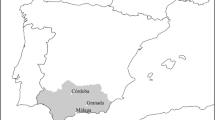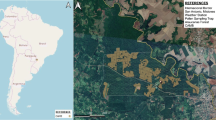Abstract
Airborne pollen concentration patterns reflect flowering phenology of a given species, and it may be a sensitive regional indicator in climate change studies. This paper presents the relationship between a strategic biological event, such as olive flowering, and the air temperature trend, registered over a large scale (1982–2007) in the Umbria region. The aim of the study was to determine relationships between phenological behaviour (flowering) of olive trees and the air temperature trend (1982–2007) in the Umbria region. The phenological data on flowering phase were registered indirectly through an aerobiological monitoring technique. The obtained results showed a strong relationship between phenology and thermal trend. This characteristic was confirmed from results of correlations between temperature (mean temperature from 1st March) and flowering dates, especially that of full flowering (r = −0.9297). Moreover, the results showed an advance trend of 6, 8 and 10 days, respectively of start, full and end of flowering dates. The advance of the recorded flowering time in this period is to ascribe mainly to the increase of mean temperature and above all to that registered in months of May and June.







Similar content being viewed by others
References
Ahas, R., & Aasa, A. (2006). The effects of climate change on the phenology of selected Estonian plant, bird and fish populations. International Journal of Biometeorology, 51, 17–26.
Alcamo J, Moreno JM, Nováky B, Bindi M et al. (2007) Europe. Climate change 2007: impacts, adaptation and vulnerability. contribution of working group II to the fourth assessment report of the intergovernmental panel on climate change, Parry ML, Canziani OF, Palutikof JP, van der Linden PJ and Hanson CE (Eds.), Cambridge University Press, Cambridge, UK, 541–580.
Beaubien, E. G., & Freeland, H. J. (2000). Spring phenology trends in Alberta, Canada: links to ocean temperature. International Journal of Biometeorology, 44, 53–59.
Bernstein L, Bosch P, Canziani O, Chen Z, Christ R, et al. (2007) Summary for policymakers, climate change 2007: synthesis report. A contribution of working groups I, II, and III to the fourth assessment report of the integovernmental panel on climate change. http://www.ipcc.ch/pdf/assessment-report/ar4/syr/ar4_syr_spm.pdf. Accessed 02 September 2008.
Bini, G. (1984). Fioritura e impollinazione nell’olivo; indagini sul periodo d’impollinazione, recettività dello stigma ed evoluzione del gametofito femminile. Rivista Ortoflorofrutticoltura It, 68, 57–69.
Bonofiglio, T., Orlandi, F., Sgromo, C., Romano, B., & Fornaciari, M. (2008). Influence of temperature and rainfall on timing of olive (Olea europaea) flowering in southern Italy. New Zealand journal of crop and horticultural science, 36(1), 59–69.
Chmielewski, F. M., & Rötzer, T. (2002). Annual and spatial variability of the beginning of growing season in Europe in relation to air temperature changes. Climate Research, 19, 257–264.
Chuine, I., Belmonte, J., & Mignot, A. (2000). A modelling analysis of the genetic variation of phenology between tree populations. Journal of Ecology, 88, 561–570.
Chuine, I., Cour, P., & Rousseau, D. D. (1998). Fitting models predicting dates of flowering of temperate-zone trees using simulated annealing. Plant, Cell and Environvironment, 21, 455–466.
D’Amato, G., Cecchi, L., Bovini, S., Nunes, C., Annesi-Maesano, I., Behrendt, H., et al. (2007). Allergenic pollen and allergy in Europe. European Journal of Allergy and Clinical Immunology, 62, 976–990.
D’Amato, G., & Spieksma, F Th M. (1990). Allergenic pollen in Europa. Grana, 30, 67–70.
Donnelly A, Salamin N, Jones MB (2006). Changes in tree phenology: an indicator of spring warming in Ireland? Biology and Environment: Procedings of the Royal Irish Accademy 106(1): 49–56.
Emberlin, J., Smith, M., Close, R., & Adams-Groom, B. (2007). Changes in the pollen season of the early flowering trees Alnus spp. and Corylus spp. in Worcester, United Kingdom, 1996–2005. International Journal of Biometeorology, 51(3), 181–191.
Estrella, N., Menzel, A., Krämer, U., & Behrendt, H. (2006). Integration of flowering dates in phenology and pollen counts in aerobiology: analysis of their spatial and temporal coherence in Germany (1992–1999). International Journal of Biometeorology, 51(1), 49–59.
Estrella, N., Sparks, T. H., & Menzel, A. (2007). Trends and temperature response in the phenology of crops in Germany. Global Change Biology, 13, 1737–1747.
Fitter, A. H., & Fitter, R. S. R. (2002). Rapid changes in flowering time in British plants. Science, 296(5573), 1689–1691.
Fornaciari, M., Galan, C., Dominguez, E., & Romano, B. (2000). Aeropalinological and phenological study in two different Mediterranean olive areas: Cordoba (Spain) and Perugia (Italy). Plant Biosystem, 134(2), 199–204.
Fornaciari, M., Pieroni, L., Orlandi, F., & Romano, B. (2002). A new approach to consider the pollen variable in forecasting yield models. Economic Botany, 56(1), 66–72.
Galán, C., Cariňanos, P., García-Mozo, H., Alcazar, P., & Dominguez-Vilches, E. (2001). Model for forecasting Olea europaea L. Airbonne pollen in south-west Andalusia, Spain. International Journal of Biometeorology, 45(2), 59–69.
Galán, C., García-Mozo, H., Vázquez, L., Ruiz, L., Díaz de la Guardia, C., & Domínguez-Vilches, E. (2008). Modeling olive crop yield in Andalusia, Spain. Agronomy Journal, 100(1), 98–104.
Galán, C., García-Mozo, H., Vázquez, L., Ruiz, L., Díaz de la Guardia, C., & Trigo, M. M. (2005). Heat requirement for the onset of the Olea europaea L. pollen season in several sites in Andalusia and the effect of the expected future climate change. International Journal of Biometeorology, 49, 184–188.
Galán, C., Vázquez, L., García-Mozo, H., & Domínguez, E. (2004). Forecasting olive (Olea europaea) crop yield based on pollen emission. Field Crops Research, 86, 46–51.
García-Mozo, H., Orlandi, F., Galán, C., Fornaciari, M., Romano, B., Ruiz, L., et al. (2009). Olive flowering phenology variation between different cultivars in Spain and Italy: modelling analysis. Theoretical and Applied Climatology, 95, 385–395.
Hackett, W. P., & Hartmann, H. T. (1964). Inflorescence formation in olive as influences by low temperature, photoperiod, and leaf area. Botanical Gazette, 125, 65–72.
Higgins, S. I., & Richardson, M. (1999). Predicting plant migration rates in a changing world: the role of long-distance dispersal. American Naturalist, 153, 464–475.
Hirst, J. M. (1952). An automatic volumetric spore-trap. Annals of Applied Biology, 39, 257–265.
IPCC (2007) Summary for policymakers. In: Climate change 2007: impacts, adaptation and vulnerability. contribution of working group II to the fourth assessment report of the intergovernmental panel on climate change, Parry ML, Canziani OF, Palutikof JP, van der Linden PJ and Hanson CE (Eds.) Cambridge University Press, Cambridge, UK, 7–22.
Jaagus, J., & Ahas, R. (2000). Space-time variations of climatic seasons and their correlation with the phenological development of nature in Estonia. Climate Research, 15(3), 207–219.
Jato, M. V., Frenguelli, G., Rodrìguez, F. J., & Aira, M. J. (2000). Temperature requirements of Alnus pollen in Spain and Italy (1994–1998). Grana, 39, 240–245.
Menzel, A., Estrella, N., & Fabian, P. (2001). Spatial and temporal variability of the phenological seasons in Germany from 1951 to 1996. Global Change Biology, 7, 657–666.
Neilson, P. R., Pitelka, L. F., Solomon, A. M., Nathan, R., Midgley, G. F., Fragoso, J. M. V., et al. (2005). Forecasting Regional to global plant migration in response to climate change. BioScience, 55(9), 749–759.
Orlandi, F., Ferranti, F., Romano, B., & Fornaciari, M. (2003). Olive pollination: flowering and pollen of two cultivars of Olea europaea. New Zealand Journal of Crop and Horticultural Science, 31, 159–168.
Orlandi, F., Romano, B., & Fornaciari, M. (2005a). Relationship between flowering and heat units to analyze crop efficiency of olive cultivars located in southern Italy. Hortscience, 40(1), 64–68.
Orlandi, F., Vazquez-Ezquerra, L., Ruga, L., Bonofiglio, T., Fornaciari, M., Garcia-Mozo, H., et al. (2005b). Bioclimatic requirements for olive flowering in two mediterranean regions located at the same latitude (Andalucia, Spain and Sicily, Italy). Annals of Agriculture and Environmental Medicine, 12, 47–52.
Osborne, C. P., Chuine, I., Viner, D., & Woodward, F. I. (2000). Olive phenology as a sensitive indicator of future climatic warming in the Mediterranean. Plant, Cell and Environment, 23, 701–710.
Pannelli, G., Alfei, B., D’Ambrosio, A., Rosati, S., & Fagiani, F. (2000). Varietà di olivo in Umbria. Perugia (Italy): Editrice Pliniana.
Peñuelas, J., & Filella, I. (2001). Phenology: Response to a warming world. Science, 294, 793–795.
Peñuelas, J., Filella, I., & Comas, P. (2002). Changed plant and animal life cycles from 1952 to 2000 in the mediterranean region. Global Change Biology, 8, 531–544.
Ribeiro, H., Cunha, M., & Abreu, I. (2005). Airborne pollen of Olea in five regions of Portugal. Annals of Agriculture and Environmental Medicine, 12, 317–320.
Richardson, E. A., Seeley, S. D., & Walker, D. R. (1974). A model for estimating the completion of rest for “Redhaven” and “Elberta” peach trees. Hort Science, 9, 331–332.
Rodríguez-Rajo, F. J., Dacosta, N., & Jato, V. (2004). Airborne olive pollen in Vigo (Northwest Spain): a survey to forecast the onset and daily concentrations of the pollen season. Grana, 43, 101–110.
Schwartz, M. D., Ahas, R., & Aasa, A. (2006). Onset of spring starting earlier across the northern Hemisphere. Global Change Biology, 12(2), 343–351.
Schwartz, M. D., & Chen, X. (2002). Examining the onset of spring in China. Climate Research, 21, 157–164.
Schwartz, M. D., & Reiter, B. E. (2000). Changes in North American spring. International Journal of Climatology, 20(8), 929–932.
Sparks, T. H., Jeffre, E. P., & Jeffre, C. E. (2000). An examination of the relationship between flowering times and temperature at the national scale using long-term phenological records from the UK. International Journal of Biometeorology, 44, 82–87.
Stefanescu, C., Peñuelas, J., & Filella, I. (2003). Effects of climatic change on the phenology of butterflies in the northwest mediterranean basin. Global Change Biology, 9, 1494–1506.
Teranishi, H., Kenda, Y., Katoh, T., Kasuya, M., Oura, E., & Taira, H. (2000). Possible role of climate change in the pollen scatter of Japanese cedar Cryptomeria japonica in Japan. Climate Research, 14, 65–70.
Williams, T. A., & Abberton, M. T. (2004). Earlier flowering between 1962 and 2002 in agricultural varieties of white clover. Oecologia, 138(1), 122–126.
Zhao, T., & Schwartz, M. D. (2003). Examining the onset of spring in Wisconsin. Climate Research, 24, 59–70.
Author information
Authors and Affiliations
Corresponding author
Rights and permissions
About this article
Cite this article
Bonofiglio, T., Orlandi, F., Sgromo, C. et al. Evidences of olive pollination date variations in relation to spring temperature trends. Aerobiologia 25, 227–237 (2009). https://doi.org/10.1007/s10453-009-9128-4
Received:
Accepted:
Published:
Issue Date:
DOI: https://doi.org/10.1007/s10453-009-9128-4




